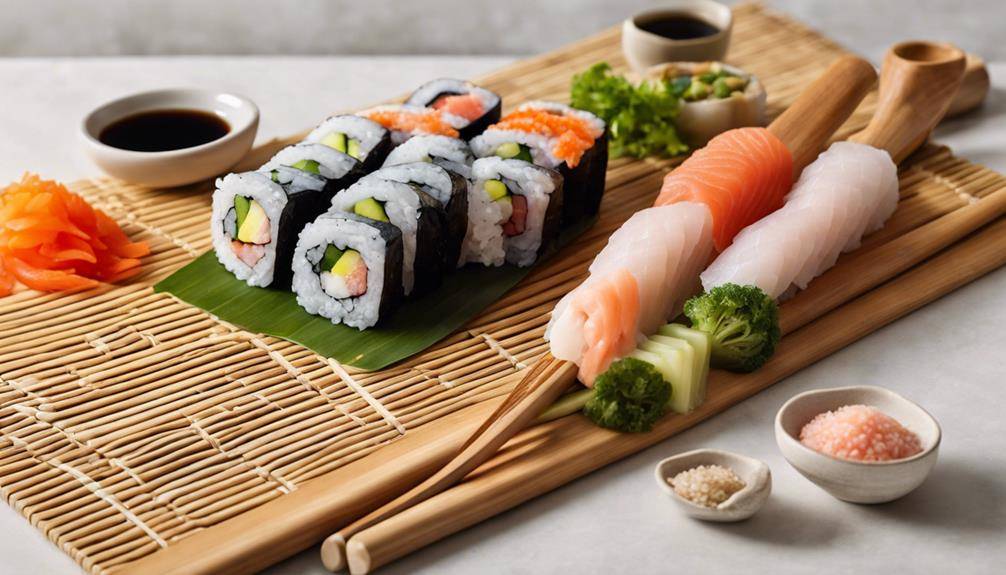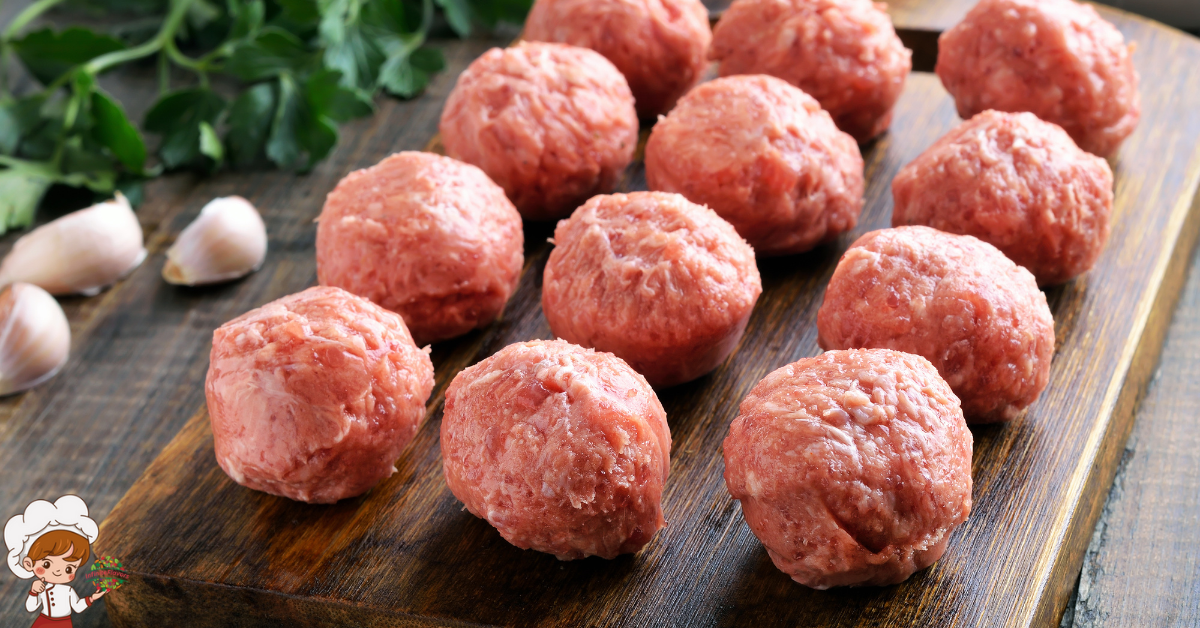The Best Rolling Pins For Rolling Sushi Rice

The Best Rolling Pins For Rolling Sushi Rice; When you’re rolling sushi rice, choosing the right rolling pin can make all the difference. Opt for a wooden pin for excellent control, or a silicone one to avoid sticking. Marble pins provide smoothness and weight for effortless rolling. Make sure your rice is perfectly prepared—sticky, tender, and seasoned properly. Use even pressure when rolling to avoid crushing your ingredients, and take your time for uniform results. Your choice of pin size matters too; shorter pins are great for small batches, while longer ones suit larger rolls. Stick around to discover more tips for perfect sushi preparation!
Importance of Sushi Rice Texture
Understanding the importance of sushi rice texture is essential for creating authentic sushi. The right texture allows the rice to hold together, making it easier for you to roll and shape your sushi. When you choose the appropriate sushi rice types, you’ll notice significant differences in texture, flavor, and overall quality. Short-grain rice is often preferred because it’s stickier, which helps the grains cling together when you’re rolling sushi.
The rice texture importance cannot be overstated. If the rice is too dry or too mushy, your sushi won’t hold its shape. You want that perfect balance where the grains are tender but firm enough to maintain structure. This texture is achieved through proper washing, soaking, and cooking techniques. Washing the rice removes excess starch, leading to a cleaner, less sticky outcome. Soaking allows the grains to absorb moisture, ensuring even cooking.
After cooking, let the rice rest to allow it to steam, enhancing its texture further. When you mix in the sushi vinegar, do it gently to avoid breaking the grains. This step not only adds flavor but also contributes to the overall mouthfeel of your sushi.
Types of Rolling Pins
To achieve that perfect sushi rice texture, having the right tools in your kitchen is just as important as the ingredients you choose. When it comes to rolling pins, you’ve got a couple of excellent options: ceramic rolling pins and stainless steel pins. Each type has its unique advantages that can enhance your sushi-making experience.
Ceramic rolling pins are a popular choice for their weight and smooth surface. They provide an even distribution of pressure, which helps you roll out your sushi rice uniformly. The non-porous nature of ceramic also means it won’t absorb flavors or odors, making it perfect for sushi preparation. Plus, many ceramic pins come with a beautiful design, adding an aesthetic touch to your kitchen.
On the other hand, stainless steel pins are known for their durability and ease of cleaning. They’re often heavier than ceramic options, allowing you to apply more force without much effort. Stainless steel pins can also be chilled in the refrigerator, which helps keep your sushi rice cold while rolling, ensuring it retains the right texture.
Ultimately, the choice between ceramic and stainless steel rolling pins depends on your personal preference and cooking style. Both types can help you master the art of sushi rice rolling, so consider trying them out to see which one suits you best.
Wooden Rolling Pins
If you’re looking for a classic option, wooden rolling pins are a great choice for sushi rice preparation. These pins provide excellent control and stability, allowing you to master the rolling techniques necessary for creating perfectly shaped sushi rolls. The solid structure of a wooden rolling pin helps you apply even pressure, ensuring that your sushi rice is rolled out uniformly without sticking.
When working with sushi rice, the right technique is vital. You’ll want to use gentle, even pressure as you roll, avoiding excessive force that could break apart the rice. Wooden rolling pins are ideal because they grip the rice lightly, letting you adjust your pressure as needed. This flexibility allows you to achieve a smooth, even layer of rice, which is essential for sushi preparation.
Another benefit of wooden rolling pins is their durability. They can withstand regular use without losing their shape or functionality. Plus, they’re easy to clean and maintain. Just a quick wash with warm, soapy water will keep your rolling pin in great condition, ready for your next sushi-making session.
Whether you’re a beginner or a seasoned sushi chef, incorporating a wooden rolling pin into your kitchen tools can elevate your sushi preparation. You’ll appreciate the tactile feedback and control it offers, making your rolling techniques more effortless and enjoyable. So, grab that wooden rolling pin and get ready to roll out some delicious sushi!
Silicone Rolling Pins
Silicone rolling pins offer a modern twist on sushi rice preparation, combining flexibility with non-stick convenience. Made from silicone materials, these pins are perfect for rolling out sushi rice without the sticky mess that comes with traditional options. Their non-stick surfaces guarantee that your rice doesn’t cling, making the entire process smoother and more enjoyable.
One of the standout features is their flexible designs. You can easily manipulate the pin to get into tight spots, guaranteeing an even roll every time. Plus, their lightweight options make them easy to handle, reducing fatigue during longer prep sessions. This is especially beneficial when you’re making multiple sushi rolls for a gathering.
Heat resistance is another significant advantage. If you happen to use your rolling pin for other culinary tasks, like working with fondant or dough, you won’t have to worry about it warping or melting. Additionally, with a wide color variety available, you can choose one that complements your kitchen or simply reflects your personal style.
Cleaning up is a breeze with silicone rolling pins. You can simply wipe them down or toss them in the dishwasher, saving you time and effort. Durability factors also play a role in their appeal; silicone pins resist wear and tear, guaranteeing they’ll be a staple in your kitchen for years to come. In short, silicone rolling pins elevate your sushi rice preparation experience, combining practicality with style.
Marble Rolling Pins
For those seeking a classic approach to sushi rice preparation, marble rolling pins stand out for their elegance and functionality. These rolling pins not only look stunning in your kitchen but also offer unique marble benefits. The smooth, cool surface of marble helps prevent the rice from sticking, allowing you to roll out your sushi rice effortlessly. This feature is particularly advantageous when you’re aiming for that perfect consistency, as it guarantees even pressure and distribution.
Additionally, marble’s weight provides you with excellent control while rolling, allowing you to apply just the right amount of pressure without excessive effort. This balance is essential when you want to maintain the integrity of the rice, making sure it doesn’t become too mushy or overworked.
When it comes to marble maintenance, you’ll find it’s relatively straightforward. Simply wipe down your rolling pin after each use with a damp cloth to remove any residue. Avoid soaking it in water or using harsh detergents, as this can damage the marble. Regularly polishing it with mineral oil will help maintain its sheen and keep it looking as beautiful as the day you bought it.
Incorporating a marble rolling pin into your sushi-making routine can enhance your experience, providing both aesthetic appeal and practical advantages. As you roll out that sushi rice, you’ll appreciate the combination of tradition and efficiency that a marble rolling pin brings to your culinary endeavors.
Adjustable Rolling Pins
Adjustable rolling pins offer you the flexibility to roll your sushi rice to the perfect thickness, making your sushi-making experience more enjoyable. When choosing the right size, consider what types of sushi you’ll be preparing most often. This way, you’ll guarantee you have the ideal tool for your culinary creations.
Benefits of Adjustable Pins
When it comes to achieving the perfect sushi rice roll, adjustable rolling pins offer a distinct advantage. These pins allow you to control the thickness of your rice layer, giving you the adjustable benefits that fixed pins simply can’t provide. With adjustable settings, you can guarantee your rice is rolled to the exact thickness needed for your favorite sushi types, enhancing your rolling precision.
You’ll find that using an adjustable rolling pin can appreciably reduce the guesswork involved in preparing sushi. Whether you prefer a thin layer for delicate rolls or a thicker base for heartier options, you can easily adapt to your desired thickness. This level of control not only simplifies the rolling process but also results in more consistent sushi rolls, which is key to impressing your guests.
Additionally, adjustable rolling pins can save you time in the kitchen. Instead of rolling out your rice multiple times to achieve the right thickness, you can simply adjust the pin to your preferred setting and roll it out in one go. This efficiency allows you to focus more on the flavors and fillings, making your sushi-making experience both enjoyable and rewarding.
Choosing the Right Size
Finding the right size of an adjustable rolling pin can make a significant difference in your sushi-making process. It’s crucial to choose a pin that suits your specific needs, especially if you often experiment with different sushi rolling techniques. A pin that’s too large may be cumbersome, while one that’s too small can limit your ability to roll larger sheets of sushi rice.
When selecting your adjustable rolling pin, consider the rolling pin materials as well. Wooden pins are great for their durability and natural grip, while silicone options offer a non-stick surface, making cleanup easier. You’ll want a size that allows you to control the thickness of your sushi rice effectively, whether you’re going for thin rolls or thicker styles.
Think about how often you’ll be making sushi and the variety of rolls you enjoy. A versatile adjustable pin, often with removable rings to set thickness, can help you master different sushi rolling techniques without hassle. Ultimately, the right size guarantees you achieve that perfect sushi roll every time, enhancing your culinary experience.
Choosing the Right Size
When it comes to choosing the right size rolling pin for sushi rice, you’ll find standard sizes that cater to different needs. Your personal preference and the space you have for storage also play a vital role in your decision. Let’s explore how these factors can impact your selection.
Standard Sizes Explained
Choosing the right size of rolling pin for sushi rice can considerably impact your preparation process, as it determines how evenly you can flatten the rice. Standard sizes typically range from 12 to 20 inches in length. A shorter rolling pin, around 12 inches, is great for small batches and allows for precise control, which can enhance your sushi rolling techniques. On the other hand, a longer pin, about 18 to 20 inches, is ideal for larger portions, making it easier to cover more surface area quickly.
When considering your rice preparation methods, think about the volume of sushi you plan to make. If you’re often preparing sushi for gatherings, a larger rolling pin may be beneficial. However, if you prefer crafting sushi for yourself or a small group, a standard 12-inch pin will suffice and can make handling easier.
Ultimately, the size of your rolling pin should align with your sushi rolling techniques and the quantity of sushi rice you typically prepare. By choosing the right size, you’ll guarantee a smoother rolling process and better results in your sushi creations.
Personal Preference Matters
For sushi enthusiasts, personal preference plays an essential role in selecting the perfect rolling pin size. You’ll find that the right size can greatly impact your sushi-making experience. If you prefer a more traditional approach, a longer rolling pin might suit your needs better, allowing for wider rolls and more intricate designs. On the other hand, if your individual style leans towards smaller, bite-sized sushi, a shorter pin might be ideal for you.
Consider the thickness of the rice and filling you typically use. A larger rolling pin can give you more control when pressing down, ensuring even rolls. However, if you often make sushi in smaller batches, a compact size can be easier to handle and store.
Ultimately, it’s about what feels comfortable in your hands and complements your sushi-making technique. Experimenting with different sizes can help you discover what aligns best with your personal preferences. Remember, the joy of sushi-making comes from the ability to express yourself, and choosing the right rolling pin size is just one way to enhance that experience. So, don’t hesitate to try out various options until you find your perfect match!
Storage Space Considerations
Finding the right rolling pin size also hinges on your available storage space. If you have a small kitchen, opting for a compact rolling pin can make a huge difference. Look for space-saving solutions that allow you to store your rolling pin without cluttering your countertops. For instance, a shorter pin can easily fit in a drawer or cabinet, while a longer one might require more room.
Consider using vertical storage to maximize your space. You can hang your rolling pin on a wall-mounted rack or a magnetic strip. This not only keeps it easily accessible but also adds a decorative touch to your kitchen. If you prefer to keep it in a drawer, guarantee there’s enough room to avoid damaging the pin or other tools.
Evaluate your rolling pin’s dimensions against your storage options. If you’re tight on space, a thinner, shorter pin might be the best choice for rolling sushi rice. Remember, the right size will enhance your cooking experience without overwhelming your kitchen. With a little thought on storage, you can keep your rolling pin handy and your space organized.
Preparing Sushi Rice
When preparing sushi rice, it is important to start with high-quality short-grain rice, as this variety provides the perfect sticky texture needed for sushi. Begin by rinsing the rice under cold water until the water runs clear. This step removes excess starch, ensuring that your sushi rice isn’t overly gummy. After rinsing, let the rice soak for about 30 minutes. This soaking period allows the grains to absorb water, which helps achieve a tender texture during cooking.
Next, cook the rice using a rice cooker or a pot on the stove. If you’re using a pot, combine one cup of rice with 1.2 cups of water, bring it to a boil, and then reduce the heat to low, covering the pot for about 18 minutes. Once cooked, let the rice sit for an additional 10 minutes, covered, to allow the steam to finish the cooking process.
Now comes the essential part of sushi rice preparation: seasoning. In a small saucepan, combine rice vinegar, sugar, and salt. Heat the mixture until the sugar and salt dissolve, but don’t let it boil. Once the rice is cool, gently fold in the seasoning using a wooden spatula to avoid smashing the grains. This rice seasoning technique is significant, as it enhances the flavor of the rice, making it perfect for sushi. After seasoning, your sushi rice is ready to be used for rolling delicious sushi!
Techniques for Rolling Sushi
Now that your sushi rice is perfectly seasoned and ready, it’s time to master the art of rolling sushi. The key to great sushi lies in effective sushi rolling techniques. Start by laying a sheet of nori on your bamboo mat, shiny side down. Wet your hands to prevent sticking, then take a handful of sushi rice and spread it evenly across the nori, leaving about an inch at the top edge.
As you apply the rice, make certain it’s not too thick; a thin layer allows for better rolling. Use your fingers to press the rice gently but firmly, making sure it adheres well. If you’re including fillings, position them in a straight line across the center of the rice. Popular fillings can range from fresh fish to vegetables, so get creative!
Now comes the essential part: rolling. Lift the bamboo mat with the edge closest to you, and fold it over the filling. Use the mat to help guide the roll, applying gentle pressure as you go. Keep rolling until you reach the exposed edge of the nori. Wet this edge with a little water to seal the roll.
Once you’ve formed a tight cylinder, let it rest for a minute before slicing. Remember, sushi rice preparation is just as important as the rolling technique, so take your time to guarantee each step is executed well. Enjoy your homemade sushi creations!
Tips for Even Pressure
To achieve even pressure while rolling sushi, focus on your hand placement. Keep your hands positioned correctly on the rolling pin to maintain control and balance. Also, stick to a consistent rolling technique to guarantee every part of the sushi gets the same treatment.
Proper Hand Placement
Your hands play an essential role in achieving perfectly rolled sushi rice, and proper placement can make all the difference. When using a rolling pin, your hand grip should be firm but relaxed. Position your hands about shoulder-width apart on the pin. This setup allows you to apply even pressure across the entire surface of the sushi rice, ensuring a consistent thickness.
As you begin your rolling technique, start with your palms facing down and your fingers wrapped around the rolling pin. This grip gives you better control and stability. Maintain a light touch with your fingertips while your palms provide the necessary force. If your fingers are too tight, you’ll risk uneven pressure that can lead to tearing the rice.
Remember to adjust your hand placement as needed. If you find yourself leaning too much to one side, shift your hands to distribute pressure evenly. This small adjustment can drastically improve the outcome. Practicing this technique will not only enhance your sushi rolling skills but also help you create rolls that are visually appealing and delicious. Focus on your hand placement, and you’ll be on your way to sushi perfection.
Consistent Rolling Technique
Mastering your hand placement sets the stage for a consistent rolling technique. Once you’ve got that down, focus on applying even pressure as you roll. Use both hands to guide the rolling pin, guaranteeing that you’re distributing your weight evenly across the surface. This technique is essential in sushi rolling, as uneven pressure can lead to lumpy sushi rolls and uneven rice consistency.
When you start rolling, keep your elbows slightly bent. This position allows for greater control and helps maintain a steady rhythm. As you roll, think of your movements as a smooth, continuous action—don’t rush! Gradually apply pressure to flatten the rice, and remember to roll from the center outwards. This sushi rolling technique helps keep your rice intact while achieving that perfect roll.
Incorporating these rice consistency tips throughout the process will help guarantee your sushi rolls come out beautifully. If you notice any areas that need more attention, simply roll back and forth in those spots for a moment. With practice, you’ll master the art of consistent rolling, creating sushi rolls that not only look great but taste amazing too!
Cleaning and Maintaining Rolling Pins
Cleaning and maintaining your rolling pins is vital for guaranteeing they remain in good condition and provide the best results when working with sushi rice. After each use, you’ll want to clean your rolling pin thoroughly to prevent sticky residue and bacteria buildup. For effective cleaning techniques, start by wiping down the pin with a damp cloth to remove any rice or moisture. If the pin is particularly dirty, use warm, soapy water and a soft sponge to scrub it gently. Avoid soaking wooden rolling pins, as this can lead to warping.
Once cleaned, make certain to dry your rolling pin completely with a clean towel. Leaving it damp can cause mold or mildew, especially if stored improperly. To maintain the quality of your rolling pin, consider applying a food-safe mineral oil every few months. This will help to keep the wood moisturized and prevent cracking.
Storage is another significant aspect of maintenance. Store your rolling pin in a cool, dry place, and avoid exposing it to direct sunlight, which can cause it to fade and dry out. If you notice any signs of wear, like splintering or deep scratches, it may be time to replace your rolling pin. By following these maintenance tips, you’ll guarantee that your rolling pin serves you well for many sushi-making sessions to come. Keeping your tools in top shape not only enhances your culinary experience but also prolongs their lifespan.
Common Mistakes to Avoid
When rolling sushi rice, it’s easy to make mistakes that can affect the texture and flavor of your rolls. One common pitfall is neglecting rice soaking. Properly soaking your rice guarantees it cooks evenly, creating the right sticky texture that holds your sushi together. If you skip this step, you might end up with dry or overly mushy rice.
Another mistake involves incorrect ingredient proportions. Achieving the perfect flavor balance is vital; too much vinegar or sugar can overwhelm your sushi. Be sure to measure your seasoning according to your preferences and the amount of rice you’re using.
When it comes to sushi assembly, don’t rush the process. Proper rolling techniques are essential for a well-formed roll. If you apply too much pressure, you risk crushing the ingredients, while too little pressure means your roll won’t hold together.
Presentation is also important, so pay attention to your serving suggestions. A beautifully plated sushi roll not only looks appealing but also honors the cultural significance of this dish. Use garnishes wisely and guarantee your rolls are cut evenly for that professional touch.
Enhancing Your Sushi Experience
Elevate your sushi experience by exploring various ways to enhance the flavors and presentation of your rolls. Start with rice seasoning techniques; a splash of rice vinegar and a hint of sugar can transform plain sushi rice into a flavor-packed base. Experiment with sushi flavor pairing by adding complementary ingredients like avocado, cucumber, or spicy tuna to your rolls.
Next, consider creative sushi fillings. Think outside the box by incorporating ingredients like cream cheese, tempura shrimp, or even fruits like mango for a unique twist. Mastering sushi rolling techniques is essential; using a rolling pin can help you achieve uniform, tight rolls that look as good as they taste.
Presentation styles play a significant role in your sushi experience. Use contrasting colors and shapes on your plate to make each roll pop. Arrange your sushi on a beautiful platter and include garnishes like pickled ginger or wasabi to elevate the visual appeal.
For sushi meal prep, consider preparing a variety of rolls ahead of time. This way, you can impress your guests with a stunning spread during sushi-themed parties. When serving, utilize sushi serving suggestions like small dipping bowls for soy sauce or decorative serving trays to create an inviting atmosphere.
Frequently Asked Questions: The Best Rolling Pins For Rolling Sushi Rice
Can I Use a Regular Rolling Pin for Sushi Rice?
You can use a regular rolling pin for sushi rice, but it’s best to choose one made from non-stick materials. Experiment with different sushi rice techniques to find what works best for your rolling style.
How Do I Prevent Sushi Rice From Sticking to the Rolling Pin?
To prevent sushi rice from sticking to your rolling pin, try using a non-stick material like silicone. You can also apply a light dusting of cornstarch or flour, enhancing your sushi rice techniques while rolling.
Are There Any Alternatives to Traditional Rolling Pins for Sushi?
You can explore various alternative tools for sushi rolling techniques. Consider using bamboo mats, silicone mats, or even your hands. Each method offers unique benefits, making it easier to create perfectly rolled sushi without a traditional rolling pin.
What Is the Ideal Weight of a Rolling Pin for Sushi Rice?
The ideal weight for a rolling pin varies, but you’ll find that a medium-weight pin made of hardwood provides the best balance. It enhances your best rolling techniques while ensuring even pressure on sushi rice.
How Often Should I Replace My Sushi Rolling Pin?
You should replace your sushi rolling pin when it shows wear or damage. Investing in quality materials enhances sushi rolling techniques, ensuring better results. A sturdy wooden or silicone pin provides long-lasting benefits for your sushi-making experience.
Conclusion
In your sushi-making journey, choosing the right rolling pin can make all the difference in achieving that perfect rice texture. Whether you opt for wood, silicone, or marble, each type offers unique benefits. Remember to apply even pressure and keep your rolling pin clean for the best results. By avoiding common mistakes, you’ll elevate your sushi experience and impress your friends and family. Now, grab your rolling pin and roll out some delicious sushi!








